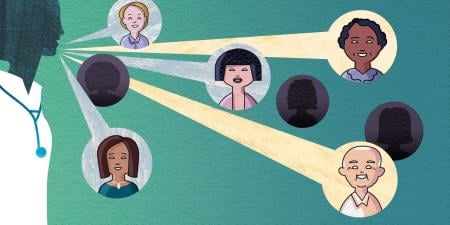Abstract
The AMA Code of Medical Ethics offers guidance on ethical issues related to naming a condition via diagnosis. This article discusses 3 case examples that consider how the AMA Code can be applied.
Three Cases of Clinicians Exercising Authority in Labeling or Naming Patients’ Conditions
Labeling or naming a patient’s condition can profoundly influence how diseases are treated, social stigmas, insurance reimbursement, and the scope of empathy towards patients. The 3 cases below examine how the American Medical Association (AMA) Code of Medical Ethics can be applied and possibly interpreted with regard to naming a patient’s condition.
Case 1. In the first case, a patient visits a dermatologist and complains of severe pruritus. Due to a prior bed bug infestation, she has taken extreme measures to fumigate and eliminate all possible affected belongings, but she still believes she suffers from pruritus and that she can see bed bugs hatching from her skin and provides the dermatologist samples. The dermatologist examines the samples, which contain keratin, not insect eggs. He suspects that the patient is suffering from a psychosomatic disorder, not pruritus caused by bed bugs. In this case, the AMA Code suggests that how the physician responds to the patient and labels her condition is an exercise of authority that requires attention to how the label “psychosomatic disorder” will influence the patient’s life and the patient-physician relationship. For example, the physician’s capacity to express respect for the patient is vital. The AMA Code addresses respect in Opinion 1.1.3, “Patient Rights,” which states, “The health and well-being of patients depends on a collaborative effort between patient and physician in a mutually respectful alliance.”1 Immediately relaying to the patient that her condition is psychosomatic could be construed by the patient as dismissive and thus as an expression of disrespect. Hasty labeling, in particular, risks undermining trust and harming the patient-physician relationship. Based on Opinion 1.1.3, the physician may have an ethical obligation to thoughtfully devise a way to impart this diagnosis that expresses respect for the patient and her experience of illness, regardless of what the illness is called or how it is labeled clinically.
Case 2. In the second case, a mother and her 14-year-old daughter visit a physician for a routine physical examination. The girl’s height and weight measurements yield a body mass index (BMI) of 30, which meets the criterion for a diagnosis of obesity. The physician recommends diet changes and regular exercise with an aim of the patient losing 10% of her body weight over the next year. A year later, the mother and daughter arrive at the physician’s office for the daughter’s yearly medical checkup. The daughter is now 15 years old and has since taken up a healthier lifestyle, including running 3 miles a day and lifting weights. However, her BMI has increased to 36, which, the physician explains, now meets the diagnostic criterion for morbid obesity and means that she is at risk for other health problems. The physician recommends bariatric surgery treatment for the girl. The mother adamantly refuses a surgery referral, insisting that her daughter is healthy. The daughter is unsure about surgery but expresses a desire to be thinner.
In this case, the patient’s mother strongly disagrees with the physician’s assessment of the patient’s health status and the physician’s recommended course of action. Opinion 2.2.1, “Pediatric Decision Making,” states:
Decisions for pediatric patients should be based on the child’s best interest, which is determined by weighing many factors, including effectiveness of appropriate medical therapies and the needs and interests of the patient and the family as the source of support and care for the patient. When there is legitimate inability to reach consensus about what is in the best interest of the child, the wishes of the parents/guardian should generally receive preference.2
This opinion suggests that the physician should consider engaging in serious discussion with the mother and daughter in order to reach consensus about which treatment is in the best interest of the minor patient. The physician should consider how labeling a patient as morbidly obese could influence her life and experiences, especially in light of recent criticisms that BMI might be an inadequate tool for assessing morbidity risks of obesity.3 It also might be counterproductive, since the label “obese” generated a defensive response from the patient’s mother. Both the patient’s physician and the patient’s parent are committed to serving the child’s best interest, but it’s the physician, not the parent, who has a professional obligation to try to recruit other stakeholders as allies. Opinion 2.2.1 states that, when consensus can’t be reached “about what is in the best interest of the child, the wishes of the parents/guardian should generally receive preference.”
Case 3. In the third case, an 83-year-old woman is concerned she’s developing a neurodegenerative disorder, such as Parkinson’s disease, and sees a neurologist for an evaluation. The patient’s history reveals worsening symptoms after recent hospitalizations, during which numerous medications were administered and prescribed. She now takes 17 medications for heart failure, atrial fibrillation, chronic obstructive pulmonary disease, diabetes, high blood pressure, and hypertension. The neurologist is not sure whether her ailments are being caused by an undiagnosed neurodegenerative disease, her current illnesses, polypharmacy,4 or some combination of these. Opinion 1.2.3, “Consultation, Referral and Second Opinions,” states that “physicians’ fiduciary obligation to promote patients’ best interests and welfare can include consulting other physicians for advice in the care of the patient or referring patients to other professionals to provide care.”5 In cases in which causes of a patient’s symptoms are unknown and there exist numerous sources of uncertainty about their origins, Opinion 1.2.3 could be interpreted as ethically obligating the physician to seek advice and consult other clinicians. In this case, consultation with other specialists before naming the patient’s condition might ultimately enable the development and implementation of a treatment plan more likely to be responsive to her specific needs and vulnerabilities.
Conclusion
How a physician defines or labels diseases when caring for patients can have significant clinical, ethical, social, and cultural consequences. The cases considered above suggest ways in which the AMA Code might be interpreted and applied in scenarios in which labeling a disease can affect not only a diagnosis, but also clinical encounters and thus the quality of patient-physician relationships.
References
-
American Medical Association. Opinion 1.1.3 Patient rights. Code of Medical Ethics. https://www.ama-assn.org/delivering-care/patient-rights. Accessed May 9, 2018.
-
American Medical Association. Opinion 2.2.1 Pediatric decision making. Code of Medical Ethics. https://www.ama-assn.org/delivering-care/pediatric-decision-making. Accessed May 22, 2018.
- Nuttall FQ. Obesity, BMI, and health: a critical review. Nutr Today. 50(3):117-128.
- Novaes PH, da Cruz DT, Lucchetti ALG, Leite ICG, Lucchetti G. The “iatrogenic triad”: polypharmacy, drug-drug interactions, and potentially inappropriate medications in older adults. Int J Clin Pharm. 2017;39(4):818-825.
-
American Medical Association. Opinion 1.2.3 Consultation, referral and second opinions. Code of Medical Ethics. https://www.ama-assn.org/delivering-care/consultation-referral-second-opinions. Accessed May 22, 2018.



